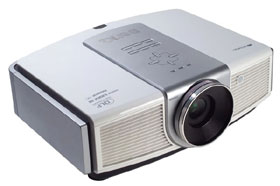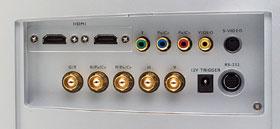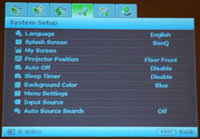 |
; |
Street Price: $2,700.00 (USD) For the serious cinema, sports, or even gaming enthusiast, BenQ’s latest offering – the W5000 1080HD DLP home theatre video projector – is fully equipped to deliver a very solid and satisfying experience. Packing some serious punch with an advertised contrast ratio of 10,000:1, 1200 ANSI lumens, a fully displayable palette of 1.07 billion colors, an image size ranging from 40 to 300 inches, and full, 1080P HD glory, BenQ certainly brought out the big guns this time. FIRST IMPRESSIONS – BenQ DLP ProjectorStyle & Appearance Weighing a hefty 21 pounds (9.6kg), and measuring in at W-19.4” x H-7.1” x D-16.5” (492 x 180 x 420 mm), the W5000 is a rather large and bulky unit that could certainly be classified as an installation unit. While it may suffer in the portability category (not that there’s anything wrong with that), you’re likely buying this unit as part of a home theatre set up, so why would you need to be shuffling it around anyway? While conventional opinion may tell us that large and bulky often means big and ugly, BenQ has proven that large and bulky can, indeed, be big and beautiful, featuring a white finish with silver trim that looks sharp and stylish. Getting Connected The W5000 1080 HD DLP home theatre video projector offers great versatility when it comes to input connections. Whether it’s HDMI (two), S-Video, RCA, Component and Composite video inputs, or true RGB BNC (R G B H V), which also double dips as a second Component (Y PB/CB PR/CR) connection, BenQ has all the bases covered.
Another smile-inducing touch: the W5000 can be set to switch automatically to whatever your active input source is, just by simply powering off the current one. This eliminates the hassle of having to toggle between various input sources until you finally find the right one. PERFORMANCE – BenQ Home Theater DLP Video ProjectorSet-Up With the W5000 home theater video projector, the offerings are neatly packaged and easily accessible. You’ll first notice that the lens bezel on this projector is positively massive – a potential landing strip for planes, if you will. While it offers a powered vertical lens shift (+120% and -80%), it unfortunately does not replicate this feature horizontally. This is obviously a by-product of the unit being primarily an installation unit. You can rectify this by placing the unit dead center to your screen and making use of the four height-adjustable feet so you can get your image laid out just right. This may also allow you to by-pass having to fiddle around with any kind of keystone adjustments. Speaking of image, due to a limited zoom lens (1.2.:1), this is definitely not a short-throw projector. If you’re looking to display an image just over 100 inches or so, anticipate having to leave at least 14 feet worth of clearance between the unit and your screen. A neat touch that can also prove to be a double-edged sword with the W5000: it features password protection. Once you have all your settings just the way you like them, you can enable a password protection that will prevent all those extra-curious types from messing around with them. Therein lies the potential rub: if you forget or misplace your six-digit password, you will be given five enter attempts to remember it. Should good fortune fail you, the unit will automatically shut down. At this point you'll be inconvenienced with having to contact BenQ for further instructions. Again, great feature, but you use it at your own risk or have your password handy at all times. In terms of accessories, the unit comes with component cables, two micro dust air filters (double-bonus joy), an actual hardcopy manual for the unit so that the burden of wasting your own paper and ink is finally spared (hooray), as well as a three-prong to two-prong AC adaptor with a ground wire. This is an added plus for those living in older buildings where outlets can sometimes prove to be an issue. Out-Of-Box Picture Out of the box, the W5000 DLP home theater projector performs admirably enough, but like most out-of-box video projectors, requires a bit of tweaking to obtain an optimal image. I performed my test with both HDMI and component connections, using a Sony PS3 for HD playback. The venerable favorite in our circles for image testing – BBC’s Planet Earth – was utilized. As the images came across my screen (using a Draper High Definition Gray Screen, clocking in at 106 inches), they had a noticeable shift towards blue (not uncommon out-of-box). While they had decent enough detail, they lacked that certain pop and vividness you get when your blacks are truly black and your whites are truly white. Compared to most projectors out-of-box though, the contrast was surprisingly pretty good. When the action shifted to noticeably brighter scenes, the image deficiencies were a little more pronounced as colors were more muted and almost pastel-like. And so begins the experiment of first fine tuning the image by eye to see what I can get. A point worth noting in advance of toggling around with different menu control options: when switching between various picture preset modes, the len iris adjusts, whereby the screen cuts to a brief moment of black, with odd, digital noise-based imagery, and an audio accompaniment that can be best described as a very short, buzz saw-type sound. I’ve probably made it sound far worse than it actually is. While a tad disconcerting at first, at least you have the audio/visual evidence that the W5000 DLP projector is actually working and making the iris adjustments. More importantly, unlike a lot of other projectors that have a self-adjusting iris that can be heard while you’re watching something (smile and say cheese, Sanyo), with the W5000 DLP home theater video projector, the iris sound ONLY occurs during set up, and NOT when you’re watching something. Now back to the topic at hand: accessing the menu screen. I first pay a visit to the Picture – Basic category.
I adjusted the settings as follows, based on various scenes from Planet Earth:
Things are looking better, but I’m feeling lucky, so I then up the ante by going to the Picture – Advanced category. I keep the BrilliantColor and DynamicBlack on (default) because it seems to give the images more punch; settle on a Gamma of 2.4, with an Iris of +19, and a Color Temperature set to Warm. Finally, I head over to the Display section of the menu and note that the Lamp is set to Whisper. Whisper is, in fact, a more refined and regal way of saying economy mode. This particular mode essentially extends the overall life of your lamp, despite its pedestrian sounding name. Lamp life as advertised on this unit ranges from 2000 to 3000 hours depending on whether you’re using Whisper or Normal mode, or switching between the two. After a few minutes of simple image tweaking based solely on eye, I now had an image I could proudly show off to impress my family and friends, because I'm like that. Blacks were black, whites were white, images were more vivid and sharp, and even the finest details in the darkest parts of the image were clear and visible. All this and I hadn't even calibrated yet.
Calibration Calibration of the W5000 was relatively quick and painless. You’ll note just how close the final picture settings were to the ones I had when I adjusted only by eye. That’s a great indicator of the superb, virtual plug and play functionality that this DLP home theater projector offers. The benefits worth noting after calibration: color tracking had marginal improvements, contrast between the darkest and lightest colors were slightly more apparent, and overall depth of image was a healthy notch above. As well, the sheer quality of the black levels was just shy of astounding. At 0 IRE, I measured a reading of 0.012 foot lamberts. You can literally count on one hand (or a few fingers) how many other projectors can achieve such noteworthy numbers. For those so inclined and equipped to perform a professional color calibration, the BenQ W5000 HD 1080P home theater video projector offers great functionality in this regard – mainly due to having certified calibration controls care of ISF on board. Ultimately, however, with respect to color calibration, whether you choose to do this or not, you will not be short-changing your viewing experience at all. For some, it’s just a case of wanting complete and total control of every little nuance an image has to offer. For most though, what you need is already nicely laid out for you in the standard user menu. FINAL THOUGHTS – BenQ DLP ProjectorWith images that offer exceptional contrast and razor sharp goodness, BenQ has done well to raise the stakes in the home theatre projector market. All this, and I haven’t even touched on how quiet this unit is during operation, or how it incorporates BenQ’s “Senseye” technology – exclusive to BenQ – which delivers the Hollywood experience to your home, with smooth video stream performance, and the ability to turn standard definition material into full-fledged, HD-like quality. All hyperbole, exposition, and technical mumbo jumbo aside, it’s really quite simple: if you’re in the market for an affordable projector that will more than satisfy all your home-viewing, home-theater needs on the grandest of scales, the BenQ W5000 is certainly a winning bet. DETAILED SPECIFICATIONS – BenQ W5000 DLP Projector
Highly Recommended
Video Projector Reviews
|
JVC DLA-X30 Review |
|||||||||||||||||||||||||||||||||||||||||||||||||||||||||||||||||||||||||||||||||||
|
Home • Projector Brands • Video Projector Reviews • Projector Resources • Contact Us
|





